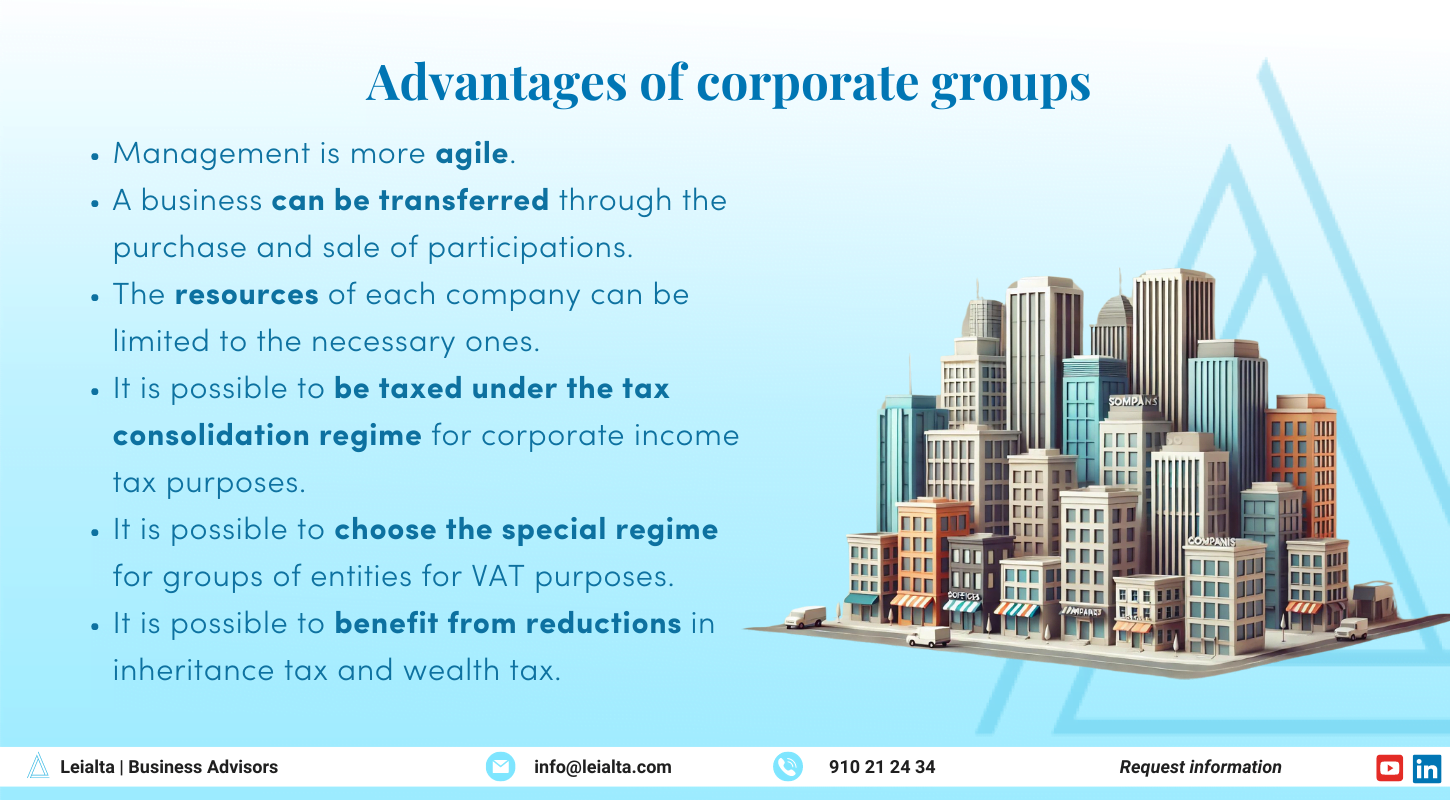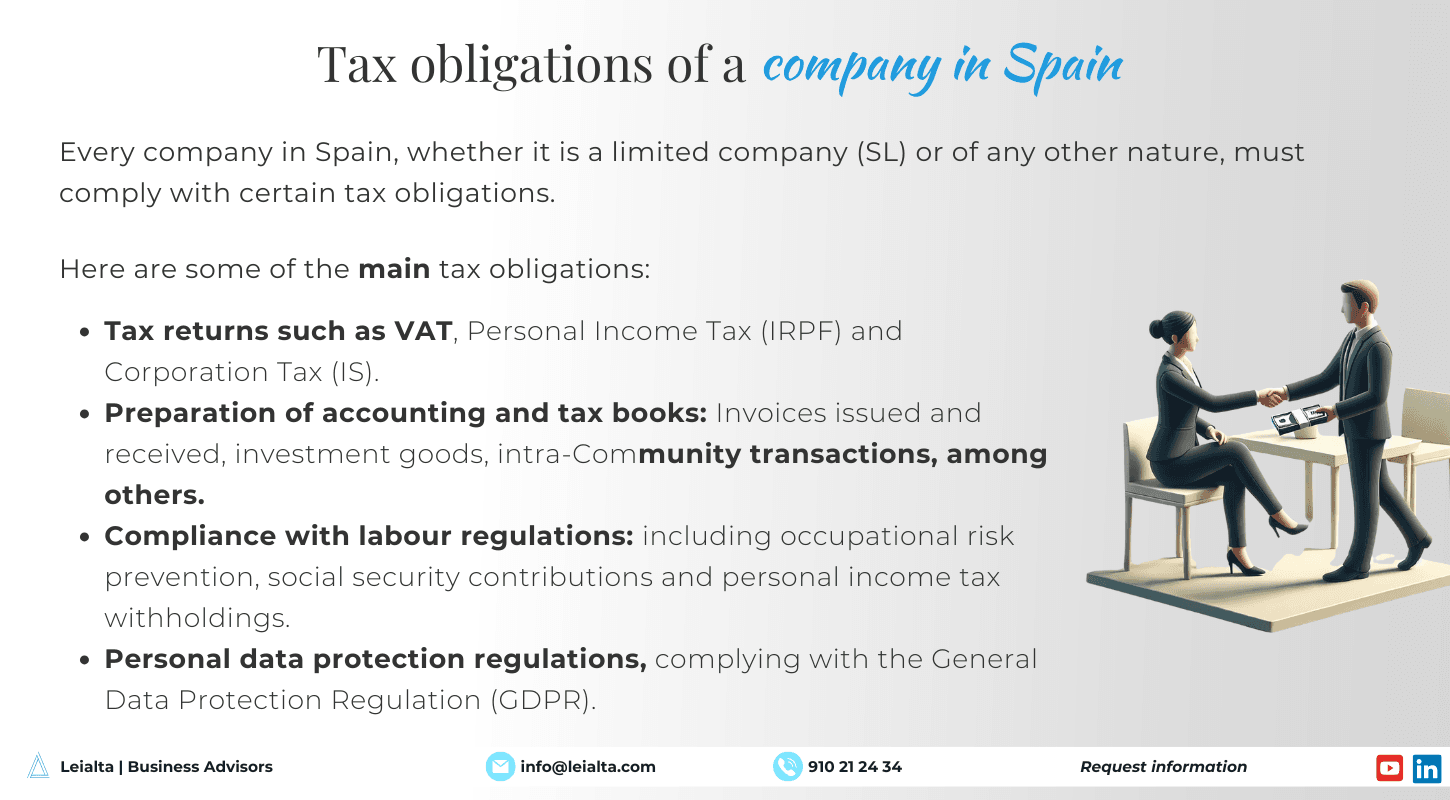
Do you want to know if you should pay VAT for groups of companies? In this post we tell you the advantages of creating a holding company and what requirements must be met to apply the special VAT group regime.
What is a corporate group and what are its advantages?
Index of contents
The definition of a group of companies is derived from Article 42 of the Commercial Code, which establishes that a group of companies exists when a company holds or may hold, directly or indirectly, control over another or others, for example, because it holds the majority of the voting rights or the power to appoint or dismiss the majority of the members of the board of directors.
For VAT purposes, a group of entities is considered to be a group of entities formed by a parent entity and its subsidiaries, provided that the headquarters of all of them are in the VAT territory (mainland Spain and the Balearic Islands).
Holding companies have the following advantages:
- Management is more agile because it is the parent company that makes the decisions.
- An activity can be transferred through the purchase and sale of shares.
- The resources of each company can be limited to those necessary.
- It is possible to be taxed under the tax consolidation regime for corporate income tax purposes. In this way, the profits generated by one company can be offset against the losses of other companies.
- It is possible to choose the special regime for groups of entities for VAT purposes.
- It is possible to benefit from reductions in Inheritance Tax and Wealth Tax.
What does the special regime for groups of entities consist of?
In order to understand the special VAT regime for groups of companies we must know that there are two levels:
Basic special regime for groups of entities
At this level, what is done is a VAT balance offset. Each entity of the VAT group must apply VAT to its operations and submit individual self-assessments on a monthly basis. The result to be paid or offset will be included in the group’s aggregate self-assessment. In the event that the aggregated self-assessment of the group is to be paid, the payment will have to be made by the controlling entity and if it is to be refunded, the controlling entity may also request a refund within the following four years from the filing of the self-assessments.
Special regime for groups of advanced entities
This level refers to the valuation of intra-group transactions. In this case, the offsetting of balances that we have seen in the basic level is included and, in addition, a series of specific rules are established to determine the taxable base for transactions between group companies.
In this special regime the value added in transactions between group entities is eliminated, i.e. the tax base is determined by the cost of the goods and services used for which the tax has been effectively borne or paid. In short, the tax burden for transactions within the tax group vis-à-vis the tax authorities is reduced.
Only the costs that supported VAT are taken into account, not including personnel, financial, commercial margins, amortization, etc.
Another benefit of this special regime, advanced level, is the waiver of the exemption of article 20.One LIVA or 20.Two LIVA for operations with the group. These entities enter in special pro-rata on a compulsory basis with the operations carried out outside the group.
The advanced level benefits all groups of companies that carry out transactions between them and cannot deduct 100% of the VAT, i.e. they are in pro-rata or have a 0% deduction.
For this advanced level it is mandatory to perform an analytical accounting, so it is advisable to have the help of a business consultancy with an experienced accounting and tax area.
What requirements must be met in order to apply the special VAT group of entities regime?
In order to apply the special VAT regime for groups of companies, the following requirements must be met:
- The companies must be located in the Peninsula and the Balearic Islands.
- The parent entity must remain in the regime for at least three years.
- The application for the application of the regime must be requested in December of the previous year and the minutes of all the companies of the group must be provided.
- The shareholding of the parent company over the rest must be over 50%.
- Holding companies may be dominant but not dependent.
- As soon as the special regime is applied, monthly forms must be filed.
What steps must be followed for the application of the special VAT regime for groups of companies?
In order to be able to apply the REGE (special VAT group regime) it is essential that the management bodies of the entities that want to apply it adopt an agreement before the beginning of the calendar year in which they want to apply the regime.
It is important to remember that the VAT group regime must be applied for three years.
For the application to be effective, once the agreement has been adopted, the controlling entity must file form 039 to inform the Tax Agency that it opts for the application of the special regime and which option it chooses (basic or advanced).
Tax Consolidation: Requirements and Advantages
What is Tax Consolidation?
Tax consolidation is an optional regime that allows a group of companies to be taxed jointly for corporate income tax purposes. This implies that consolidated returns are filed, where the profits and losses of the different companies in the group are offset against each other. In this way, the total tax burden of the group is optimized.
Requirements for Tax Consolidation
In order to qualify for the tax consolidation regime, companies must meet certain requirements:
- The parent company must hold at least 75% of the capital of the subsidiaries, or 70% if the subsidiaries are listed.
- All the companies in the group must be subject to the same tax rate.
- The companies must form a group from the beginning of the tax period.
Advantages of Tax Consolidation
The tax consolidation regime offers several advantages:
- Loss offset: Losses of one company can be offset against the profits of another, which reduces the taxable income of the group.
- Administrative simplification: A single consolidated tax return is filed, which simplifies the group’s tax management.
- Tax planning: It allows for better planning and tax optimization of the group.
How does Tax Consolidation affect VAT?
Fiscal consolidation in Corporate Income Tax and the special VAT group regime are two figures that can be combined to optimize the tax burden of a group of companies. While fiscal consolidation allows the offsetting of profits and losses in Corporate Tax, the special VAT group regime allows an integrated management of VAT, reducing the tax burden and simplifying administrative procedures.
In short, the combination of both regimes can be highly beneficial for companies, allowing a more efficient tax management and a significant reduction of the overall tax burden of the group.
The special VAT group regime and tax consolidation
The special VAT group regime and tax consolidation are powerful tools for the tax optimization of groups of companies. Taking advantage of these options can result in significant savings and more efficient management of tax obligations. If you are considering these options for your business group, it is advisable to rely on the advice of tax and accounting experts to ensure compliance with all the requirements and the correct implementation of these regimes.
Related posts



